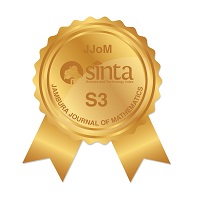Perbandingan Value at Risk dan Expected Shortfall pada Portofolio Optimal menggunakan Metode Downside Deviation
Abstract
Keywords
Full Text:
PDFReferences
E. Tandelilin, "Dasar-dasar manajemen investasi" Manajemen Investasi, vol. 34, pp. 117-121, 2010.
F. S. Mar'ati, "Mengenal Pasar Modal (Instrumen Pokok dan Proses
Go Public)" Among Makarti, vol. 3, no. 1, pp. 79-88, 2010. doi: 10.52353/ama.v3i1.19.
S. Hasbiah, Anwar, and B. Bado, "Model Markowitz dalam Keputusan Investasi Saham pada Index LQ45 di Bursa Efek Indonesia" Jekpend, vol. 5, no. 1, pp. 69-77, 2022. doi: 10.26858/jekpend.
I. W. E. Sultra, M. R. Katili, and M. R. F. Payu, "Metode Simulasi Historis untuk Perhitungan Nilai Value At Risk pada Portofolio dengan Model Markowitz" Euler : Jurnal Ilmiah Matematika, Sains dan Teknologi, vol. 9, no. 2, pp. 94-102, Dec. 2021. doi: 10.34312/euler.v9i2.11518.
E. P. Setiawan and D. Rosadi, "Model Pengoptimuman Portofolio MeanVariance dan Perkembangan Praktisnya" Jurnal Optimasi Sistem Industri, vol. 18, no. 1, pp. 25-36, May 2019. doi: 10.25077/josi.v18.n1.p25-36.2019.
I. B. A. Darmayuda, K. Dharmawan, and K. Sari, "Estimasi Expected Shortfall dalam Optimalisasi Portofolio dengan Metode Downside Deviation pada Saham IDXHEALTH" E-Jurnal Matematika, vol. 12, no. 2, pp. 114-120, 2023. doi: 10.24843/MTK.2023.v12.i02.p408.
Y. Konan, D. Kusnandar, and N. Imro'ah, "Penerapan Metode Exponentially Weighted Moving Average dan Metode Semi Varians dalam Perhitungan Risiko Portofolio Saham" Bimaster: Buletin Ilmiah Matematika, Statistika dan Terapannya, vol. 11, no. 2, pp. 309-318, 2022. doi: 10.26418/bbimst.v11i02.53482.
H. J. Atmaja, "Analisis Pemilihan Portofolio Optimal pada 27 Saham LQ45 BEI" Universitas Terbuka, 2011.
R. D. Ramadhan, S. R. Handayani, and M. G. W. Endang, "Analisis pemilihan Portofolio Optimal dengan Model dan Pengembangan dari Portofolio Markowitz (Studi pada Indeks BISNIS-27 di Bursa Efek Indonesia periode 2011-2013)" Jurnal Administrasi Bisnis, vol. 14, no. 1, pp. 1-10, 2014.
S. A. Heryanti, "Perhitungan Value at Risk pada Portofolio Optimal : Studi Perbandingan Saham Syariah dan Saham Konvensional" IKONOMIKA, vol. 2, no. 1, pp. 75-84, May 2017. doi: 10.24042/febi.v2i1.943.
R. Rahmawati, A. Rusgiyono, A. Hoyyi, and D. A. I. Maruddani, "Expected Shortfall untuk Mengukur Risiko Kerugian Petani Jagung" Media Statistika, vol. 12, no. 1, pp. 117-128, Jul. 2019. doi: 10.14710/medstat.12.1.117-128.
E. K. Dewi, D. Ispriyanti, and A. Rusgiyono, "Expected Shortfall pada Portofolio Optimal dengan Metode Single Index Model (Studi Kasus pada Saham IDX30)" Jurnal Gaussian, vol. 10, no. 2, pp. 269-278, May. 2021. doi: 10.14710/j.gauss.10.2.269-278.
R. T. M. C. Simorangkir, "Pengaruh Kinerja Keuangan terhadap Return Saham Perusahaan Pertambangan" Jurnal Bisnis dan Akuntansimn, vol. 21, no. 2, pp. 155-164, Dec. 2019. doi: 10.34208/jba.v21i2.616.
A. Solihatun, L. Gubu, E. Cahyono, and L. O. Saidi, "Perhitungan Value at Risk (VaR) pada Portofolio Saham IDX Sektor Keuangan (IDXFINANCE) menggunakan Metode Simulasi Historis (Historical Simulation Method)" JMKS (Jurnal Matematika dan Statistika), vol. 3, no. 1, pp. 245-254, 2023.
Y. Saepudin, H. Yasin, and R. Santoso, "Analisis Risiko Investasi Saham Tunggal Syariah dengan Value at Risk (VaR) dan Expected Shortfall (ES)" Jurnal Gaussian, vol. 6, no. 2, pp. 271-280, 2017. doi: 10.14710/j.gauss.6.2.271-280.
DOI: https://doi.org/10.37905/jjom.v6i2.24326
Copyright (c) 2024 Indah Nugrahaeni, Hendra Perdana, Neva Satyahadewi

This work is licensed under a Creative Commons Attribution-NonCommercial 4.0 International License.
Jambura Journal of Mathematics has been indexed by
Jambura Journal of Mathematics (e-ISSN: 2656-1344) by Department of Mathematics Universitas Negeri Gorontalo is licensed under a Creative Commons Attribution-NonCommercial 4.0 International License. Powered by Public Knowledge Project OJS.
Editorial Office
Department of Mathematics, Faculty of Mathematics and Natural Science, Universitas Negeri Gorontalo
Jl. Prof. Dr. Ing. B. J. Habibie, Moutong, Tilongkabila, Kabupaten Bone Bolango, Gorontalo, Indonesia
Email: [email protected].




















